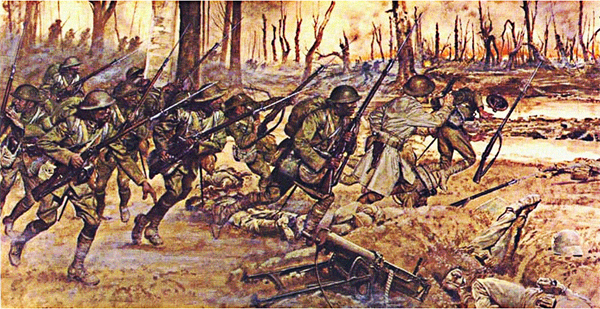
World War I: Argonne Forest in France - U.S. Sergeant Alvin C. York single-handedly took out a German machine-gun battalion, killing over a dozen and capturing 132 on October 08, 1918
World War I: Argonne Forest in France - U.S. Sergeant Alvin C. York single-handedly took out a German machine-gun battalion, killing over a dozen and capturing 132: In the long and storied 243-year history of the U.S. Army, the exploits of Sgt. Alvin C. York on October 8, 1918, in the Argonne Forest in World War I stand as one of the all-time greatest individual feats of an American soldier. In battle that day, then Corporal York killed 25 Germans, captured 132 and knocked out 35 machine guns.
After the war, York excelled as a contributing citizen to his community and nation. He worked to improve the lives of the children in his rural Tennessee community, especially in the area of education, and helped promote the homefront war effort during World War II. His life is a shining example of a Soldier for Life.
York came from humble beginnings. He was born on a farm near Pall Mall, Tennessee, on Dec. 13, 1887. Raised in poverty as one of 11 children, he worked to help support his family, particularly after the death of his father. He was prone to fighting and drinking as a young man. However, after finding God in early 1915, York’s life changed dramatically. He became a solid citizen of his community.
Conscientious Objector Drafted
Meanwhile, World War I was raging in Europe, Asia and Africa. When the U.S. declared war on the Central Powers in April 1917, the Selective Service Act of 1917 instituted a draft. York was notified to register. Though he had asked for an exemption from the draft for his religious beliefs, identifying himself as a conscientious objector, his request was denied, and he was subsequently drafted. He reported to Camp Gordon, Georgia., in November 1917; he began training while wrestling with his conscience as he pondered the Bible’s Old Testament admonition against killing.
York’s chain of command, specifically his battalion commander, Major George Buxton, and his company commander, Captain E.C.B. Danforth Jr., won his respect and admiration for their professional and understanding methods of leadership. Granted a pass to go home to ponder his situation in March 1918, York decided to go with his unit to war.
In February 1918, York was assigned to the 82nd “All American” Division. He deployed to France in April 1918. Before moving to the front, York stayed true to his Christian beliefs, avoiding alcohol, cursing and fighting. His favorite companions were his Bible and his diary. His unit, G Company of the 328th Infantry Regiment, moved toward the front in July 1918. As part of the 82nd Division, they were destined to push forward in the Meuse-Argonne Offensive beginning in late September until the armistice on November 11, 1918.
The offensive was an all-out push by the Allies across the Western Front in Belgium and France to break the German defensive lines. The offensive would eventually place growing pressure on the German defenses in and around the Hindenburg Line to wear down and ultimately break the Imperial German Army. Nine U.S. divisions began the assault, followed by four divisions in reserve. The number of units engaged would grow as the fighting continued.
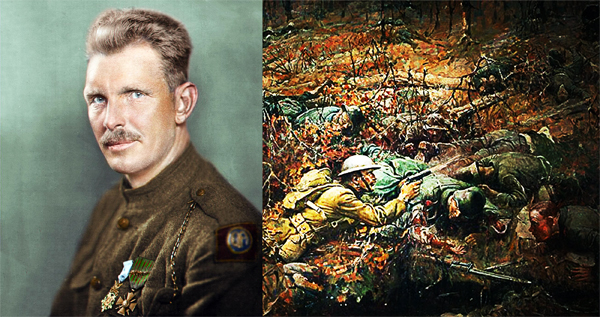
Fateful Battle
On the day of his historic action, York was part of a 17-man section moving just behind German lines looking for a gap for his company to advance in the Argonne Forest. The terrain was wooded, hilly and marshy, and the Germans had had four years to fortify it. The Argonne Forest fighting has been described as similar to the Hürtgen Forest fighting in World War II in Germany, a terrible place for a battle.
York’s company was tasked with moving over a hill and cutting the German resupply route, the Decauville Railroad, in the center of the forest. York’s company took heavy fire and suffered casualties. That led to the 17 men, under Sgt. Bernard Early, moving to find a gap in the German lines to flank and silence the machine guns holding up the advance.
Surprising some German medics as they moved deeper behind the enemy’s main line, the Americans followed the fleeing medics into a German command post, taking the command post by surprise and capturing the Germans there. While rounding up their prisoners, the Americans came under fire from nearby German machine gunners. The German fire killed several American soldiers and badly wounded Early, leaving York in command of the remaining troops.
York began shooting from the prone position with his bolt-action rifle, picking off German machine gunners as they raised their heads to spot targets. The prone firing position was familiar to York from his days of shooting matches in the Tennessee hills. At one point, six Germans tried to rush him. York killed them with his pistol, shooting from the farthest to the closest, a shooting trick he learned from his turkey hunting days back home.
The German major at the captured command post, seeing York’s shooting, offered to signal the remaining Germans to surrender. York agreed, and the surviving Americans took 80 to 90 German prisoners and had them carry the three wounded Americans as they began moving toward American lines. Going back through the German front line, York forced the major to signal German units around them to surrender, eventually winding up with 132 prisoners. In the fighting, York killed 25 Germans and silenced 35 machine guns.
Accolades for Bravery
York saw additional fighting up until November 1, 1918, when his unit was pulled back to a rest camp. Word of the November 11 armistice reached York’s unit while they were recovering at Aix-les-Bains. As was his habit, York went to church that day, wrote home and read a little. He was glad the fighting was over.
Word of York’s incredible feat spread through the ranks and he received various decorations for his exploits. Marshal Ferdinand Foch, Supreme Allied Commander in 1918, said when decorating York with the Croix de Guerre,
“What you did was the greatest thing accomplished by any private soldier of all the armies of Europe.” General John J. Pershing, commander of the American Expeditionary Forces, presented York with the Medal of Honor in 1919.
Amazingly, York’s exploits were unknown to the American public until The Saturday Evening Post ran an article about him on April 26, 1919. The publicity turned York into a national hero. Though offered numerous financial opportunities upon his return through New York City to Tennessee, York declined them all. He continually stated, “This uniform of Uncle Sam’s ain’t for sale.” He sought a return home to Pall Mall, respite and marriage to his fiancée Gracie.
York then dedicated himself to bettering his community. He successfully petitioned the Tennessee Department of Highways and Public Works to build a road through the mountains around his home. This galvanized the surrounding counties to do the same, providing a much-improved road network in that area of the state.

Dream Realized
He then began a push to get a modern school in the area, a dream realized in 1929 when the York Agricultural Institute opened, named for him. York also pushed for military preparedness leading up to World War II, then tried to enlist upon the United States’ entry into that war. Denied enlistment due to poor health, he was commissioned as a Signal Corps major and traveled to help sell war bonds and inspire recruits at training bases.
York suffered from strokes, pneumonia and failing eyesight in his later years. He passed away in Nashville, Tennessee, on September 2, 1964.
York’s life story has been told in several books. In 1940, he agreed to the cinematic telling of his story by Warner Bros. in the Howard Hawks’ movie Sergeant York. The movie was the highest-grossing film in 1941, and Gary Cooper earned an Academy Award for Best Actor for portraying the title character.
York is also recognized in the U.S. Army Center of Military History’s American Military History textbook used by Army ROTC departments to this day.
York exemplified Army values in his life. His personal courage in combat, his selfless service to his community in using his fame to better their lives, his loyalty to God and nation in his conduct during and after World War I, and his sense of duty to serve in one war and volunteer to serve in another stand as shining examples to all who serve.
GRAPHIC NOVEL ON YORK PUBLISHED BY AUSA
A graphic novel about Medal of Honor recipient Sgt. Alvin C. York was released by the Association of the U.S. Army on the 100th anniversary of York’s heroic deeds during the Meuse-Argonne Offensive. This first illustrated digital book published by AUSA
Association Of The United States ARMY
Association Of The United States ARMY / Wikipedia / Encyclopedia Britannica /
Teach Tennessee History.org / History Channel / ARMY.mil /
Military.com / National Archives.gov /
World War I: Argonne Forest in France - U.S. Sergeant Alvin C. York single-handedly took out a German machine-gun battalion, killing over a dozen and capturing 132 on October 08, 1918 (YouTube) 
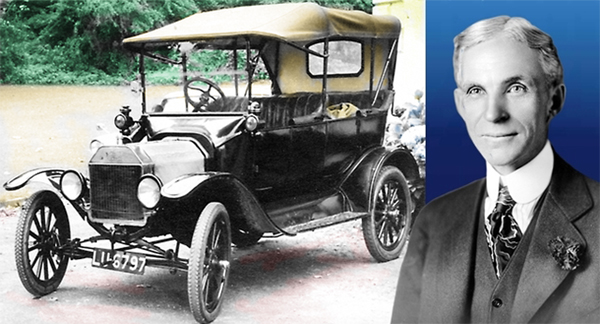
Henry Ford's Model T, a “Universal Car” designed for the masses, went on sale for the first time on October 01, 1908
Henry Ford's Model T, a “Universal Car” designed for the masses, went on sale for the first time on October 01, 1908
The Ford Model T (colloquially known as the Tin Lizzie and Flivver) is an automobile that was produced by Henry Ford's Ford Motor Company from 1908 through 1927.
The Model T set 1908 as the historic year that the automobile came into popular usage. It is generally regarded as the first affordable automobile, the car that “put America on wheels”; some of this was because of Ford's innovations, including assembly line production instead of individual hand crafting, as well as the concept of paying the workers a wage proportionate to the cost of the car, so they would provide a ready made market. The first production Model T was built on September 27, 1908, at the Piquette Plant in Detroit, Michigan. The Model T was the first automobile mass produced on assembly lines with completely interchangeable parts, marketed to the middle class.
Ford is often quoted as saying
“I will build a motorcar for the great multitude.”
At the time it was a revolutionary business model to lower a product's cost and the company's profit margin in exchange for increased sales volume. Up until this point in time the automobile had been a status symbol and cars were painstakingly built by hand for the wealthy. By the end of 1913 Ford's application of the moving assembly line had improved the speed of chassis assembly from 12 hours and eight minutes to one hour and 33 minutes. In 1914 Ford produced 308,162 cars, which was more than all 299 other auto manufacturers combined. By the time the last Model T was built in 1927, the company was producing an automobile every 24 seconds.

It was on October 1,1908, just about a month before William Howard Taft defeated William Jennings Bryan for the Presidency of the United States, that the Ford Motor Company unveiled the little machine that many historians think of as the most significant automobile of all time - the 1908-1927 Ford Model T.
Henry Ford called it the Model T - hardly surprising since Henry had already run through the alphabet from A to S, though a lot of letters were skipped along the way. It was built only as a touring car at first, but within a few months a number of other body styles would be added to the line. Strictly a utilitarian vehicle, the Ford took no beauty prizes, and it won no speed contests.
Still, its 22-horsepower, four-cylinder engine could propel the 1,200-pound car to a top speed of between 35 and 40 miles an hour, adequate for the mostly unpaved roads of the era. Cooling was by the primitive thermo-siphon method, lubrication via a splash system. The gas tank nestled beneath the front seat, its fuel being fed to the engine by the force of gravity. Meanwhile, the driver shifted the two-speed planetary transmission with foot pedals. The car didn't even have demountable rims at first, though in 1919 they became available for an extra $25.
World History Project.org / Wikipedia / Encyclopedia Britannica /
Detroit Historical.org / The American Society of Mechanical Engineers / World History Project.org /
Automotive History.org / FORD Corporate /
The Atlantic /
Henry Ford's Model T, a “Universal Car” designed for the masses, went on sale for the first time on October 01, 1908 (YouTube) 

Understanding Military Terminology
Radio Frequency Countermeasures
(DOD) Any device or technique employing radio frequency materials or technology that is intended to impair the effectiveness of enemy activity,particularly with respect to precision guided weapons and sensor systems.
Also called RF CM.
Joint Publications (JP 3-13.1) Electronic Warfare
Radiological Dispersal Device
(DOD) An improvised assembly or process, other than a nuclear explosive device, designed to disseminate radioactive material in order to causedestruction, damage, or injury.
Also called RDD.
Joint Publications (JP 3-11) Operations in Chemical, Biological Radiological, and Nuclear Environments - Joint Chiefs of Staff
Radiological Exposure Device
(DOD) A radioactive source placed to cause injury or death.
See also RED.
Joint Publications (JP 3-11) Operations in Chemical, Biological Radiological, and Nuclear Environments - Joint Chiefs of Staff
Joint Publication - Department of Defense Dictionary of Military and Associated Terms
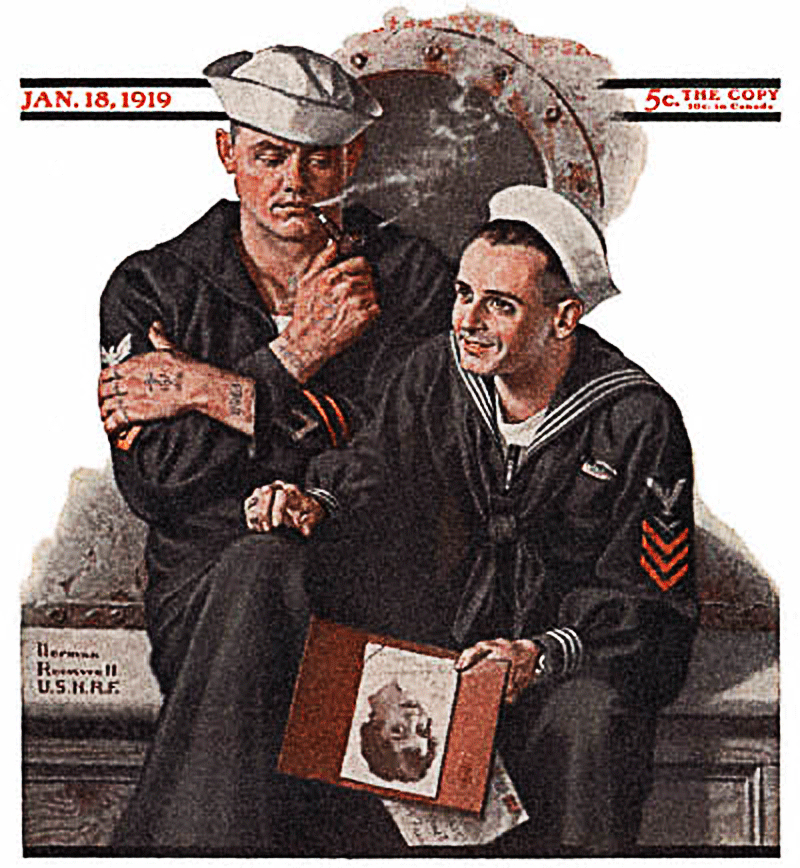
The Old Salt’s Corner

In sailing and warfare, hull-down means that the upper part of a vessel or vehicle is visible, but the main, lower body (hull) is not; the opposite term hull-up means that all of the body is visible.
The terms originated with sailing and naval warfare in which the curvature of the earth causes an approaching vessel to be first visible “sails-up”. Beginning in the 20th century, hull-down has also been used in armored warfare.
In modern armored warfare, hull-down is a position taken up by an armored fighting vehicle (AFV) so that its hull (the main part of the vehicle) is behind a crest or other raised ground, but its turret (or a superstructure or roof-mounted weapon) is exposed.
Turret-down is the position in which the vehicle's crew can observe forward from roof hatches, but the vehicle is completely hidden (usually a few meters further back from a hull-down position).
The belly armor should not be exposed, because it is vulnerable to even modest antitank weapons.

“I’m Just Sayin”
“It is a wise father that knows his own child.”
“It is not in the stars to hold our destiny but in ourselves.”
“We know what we are,
but know not what we may be.”
“A fool thinks himself to be wise,
but a wise man knows himself to be a fool.”
“God has given you one face,
and you make yourself another.”
“Some are born great,
some achieve greatness,
and some have greatness thrust upon them.”
“All the world's a stage,
and all the men and women merely players:
they have their exits and their entrances;
and one man in his time plays many parts,
his acts being seven ages.”
~ William Shakespeare

“Thought for the Day”
“It is double pleasure to deceive the deceiver.”
“One who deceives will always find those who allow themselves to be deceived.”
“It is not titles that honor men,
but men that honor titles.”
“It is better to be feared than loved
if you cannot be both.”
“Coming together is a beginning;
keeping together is progress;
working together is success.”
“There is nothing more difficult to take in hand,
more perilous to conduct,
or more uncertain in its success,
than to take the lead in the introduction of a new order of things.”
~ Niccolo Machiavelli

“What I Learned”
“If you're going through hell, keep going.”
“A lie gets halfway around the world before the truth has a chance to get its pants on.”
“We make a living by what we get,
but we make a life by what we give.”
“A pessimist sees the difficulty in every opportunity;
an optimist sees the opportunity in every difficulty.”
“You have enemies? Good.
That means you've stood up for something,
sometime in your life.”
“Success is not final,
failure is not fatal:
it is the courage to continue that counts.”
“Now this is not the end.
It is not even the beginning of the end.
But it is, perhaps,
the end of the beginning.”
~ Winston Churchill
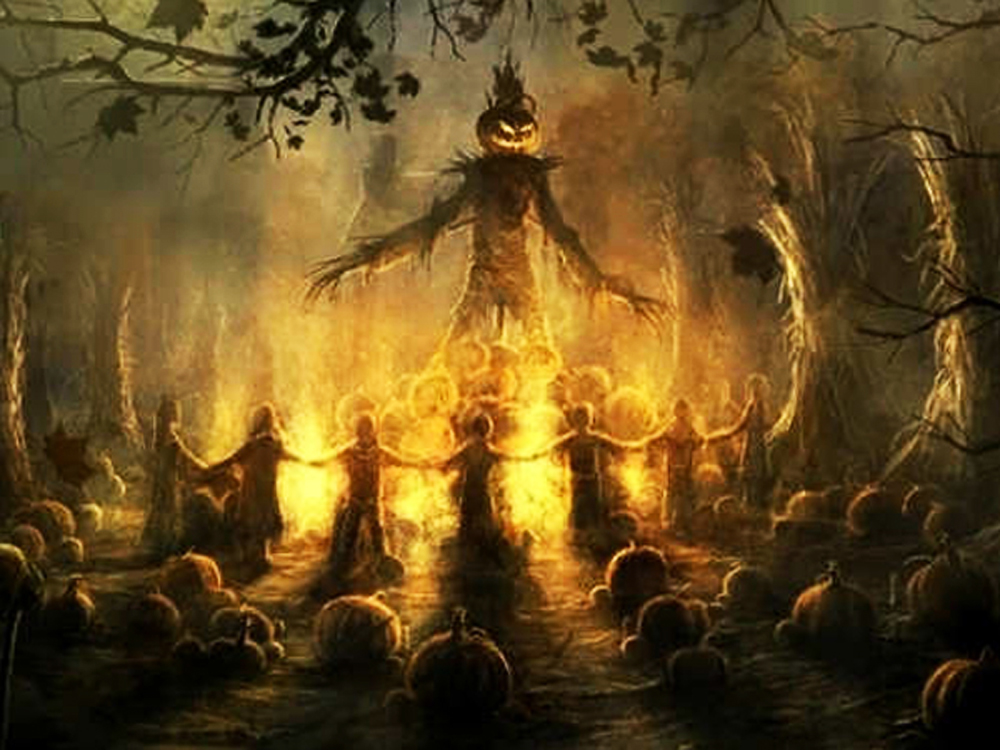
Mr. Answer Man Please Tell Us: Burning Halloween Questions
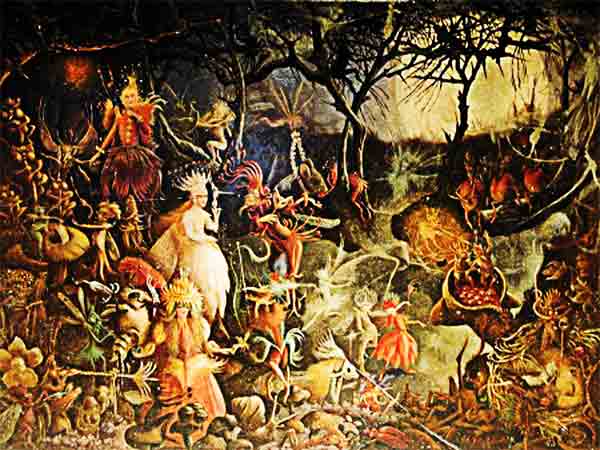
WHO STARTED HALLOWEEN?
Halloween got its start thousands of years ago, and we can thank the Celts for getting things going. They celebrated a holiday known as Samhain on October 31, one of the four “quarter days” of the calendar, and possibly the Celtic New Year. They believed that the dead could walk the earth on Samhain and cause mischief but, on the plus side, their presence also made it easier for the Druid priests to predict the future.
WHY DO WE WEAR COSTUMES?
On Samhain, a big bonfire would be built and sacrifices made to the dead, while the common folk would dress up in animal skins and try to tell their own fortunes (probably with the same success rate as the “professionals”). The costumes, Halloween's most enduring tradition, were donned either to calm the spirits or to blend in with them, so as to not incur their wrath.
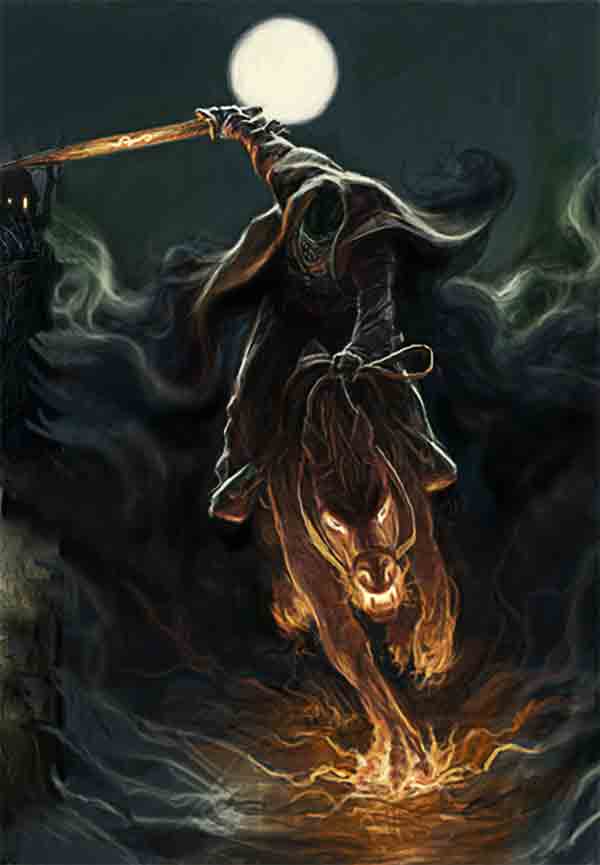
HOW DID SAMHAIN BECOME HALLOWEEN?
Starting in 43 CE, the Roman war machine rolled through Britain and conquered a large chunk of the Celtic population. But the Romans, always the master conquerors, cleverly blended two of their own holidays with the Celtic Samhain to make the transition to Roman rule more seamless. One holiday was a celebration of the dead (easy enough to mix with Samhain) and the other was a celebration of the Pomona, the goddess of fruit and tress, where, supposedly, the tradition of bobbing for apples takes root.
When Christianity arrived on the scene, the hodgepodge holiday again was forced to change. Like the previous blending, the Christians incorporated their own holidays into the Samhain tradition. November 1 became All-hallow's, a day to celebrate the saints and martyrs, and October 31 became All-hallow's Even (“Even” being short for “evening”, and providing the “n” in “Halloween”). Through the magic of etymology, All-hallow's Even became Halloween.
HOW DID WE GET FROM BONFIRES AND DEAD SAINTS TO PLASTIC MASKS AND CANDY CORN?
Puritans in New England suppressed the superstitious holiday. In the South, however, where religious piety was less important, Halloween was celebrated in much the same way it was in Europe. But a great tide of immigration in the late 1800s brought a new life to the holiday, and no amount of piety could contain it.
Through the years, the “spookiness” of Halloween was replaced with a more wholesome community feel, out of which grew trick-or-treating and, as towns celebrated together, stripped any religious significance away. Finally, after many thousands of years and many cultural modifications, we arrived at a holiday involving witches, costumes, candy, mischief, the deceased and pumpkins.
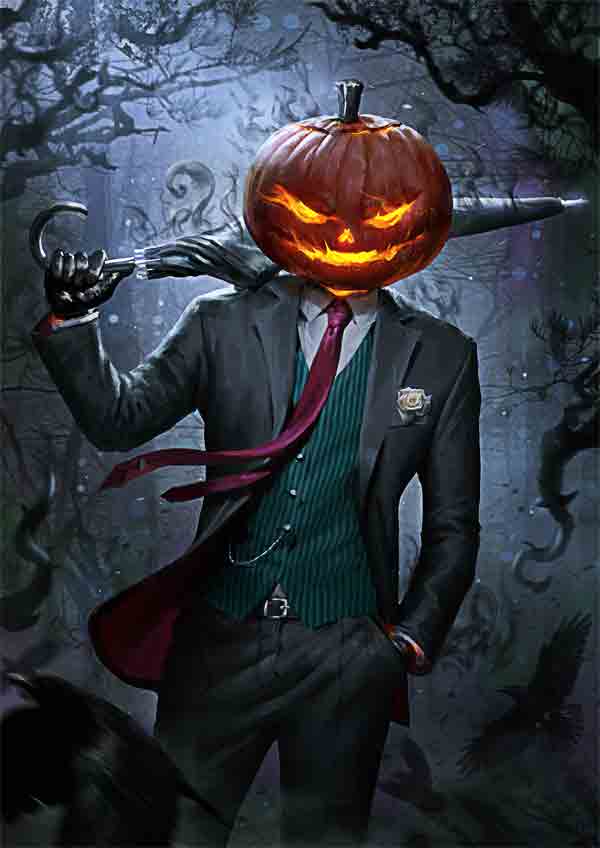
WHY PUMPKINS?
Making vegetable lanterns can be traced back to Great Britain and Ireland, where carving turnips, beets and potatoes had been a fall tradition for many centuries. According to an Irish myth, a man named Stingy Jack once had a drink with the Devil and, when he didn't want to pay for it, he convinced the Devil to turn into a coin. However, Stingy Jack lived up to his name and pocketed the coin next to a cross, keeping the Devil locked in a monetary state until he struck a deal with Jack to leave him alone and not claim his soul for Hell upon his death. When Jack did die, Heaven rejected him and, true to his word, so did the Devil.
As punishment for his trickery, the Devil sent Jack out to wander the earth forever with a single coal in a hollowed-out turnip to light his way. To Irish children he was Jack of the Lantern or, as the Irish are wont to do when confronted with an “of the”, Jack O'Lantern.
But Jack-o'-Lanterns were not a part of Halloween celebrations in Britain; it would take a new continent to cement that tradition. The first mention of a Jack-o'-Lantern being part of a Halloween celebration comes from a Canadian paper which, in 1866, wrote, “The old time custom of keeping up Hallowe'en was not forgotten last night by the youngsters of the city. They had their maskings and their merry-makings, and perambulated the streets after dark in a way which was no doubt amusing to themselves. There was a great sacrifice of pumpkins from which to make transparent heads and face, lighted up by the unfailing two inches of tallow candle.”
WHY DID PUMPKINS BEAT OUT TURNIPS, BEETS AND POTATOES?
Pumpkins abounded in America and were much better for carving and illuminating than any of the aforementioned veggies. We can assume the tradition of smashing pumpkins originated very soon after the carved pumpkin entered the Halloween celebration in the late 1800s.

WHERE DOES CANDY CORN COME FROM?
Nobody knows who invented candy corn, but we do know it began to appear in the 1880s, and we know the first company to make it commercially was the Wunderle Candy Company of Philadelphia. Soon after, the Goelitz Confectionery Company began production of candy corn in Cincinnati in 1898. The process at first was daunting: a candy blend was mixed up, heated and then poured by hand into molds. Each mold needed three separate pours to achieve the tri-color glory that is candy corn. Today the process is mechanized and the tri-color composition isn't nearly as impressive as it was to the people of the 19th century, but Goelitz has never changed the recipe and they continue to make the candy to this day. The Goelitz Confectionery Company even went on to invent another fairly popular candy a few decades later, although they had to change the company name to do so. Today they are known as Jelly Belly.
History Channel
• Library of Congress
• Live Science
• Mental Floss
• Pumpkin Patches and More.org
• Quara
• Wikipedia

NAVSPEAK aka U.S. Navy Slang
TACCO: Tactical Coordinator. Usually the senior NFO on a patrol aircraft.
Tack On Crow: (Hazing) When promoted in rank, senior and equivalent ranks would tack the crow (solidly punching) patch on one's arm as good luck so it does not “fall off”. Marines have an equivalent “tack” on each side. Can be “simulated” for a non-hazing by equal connotation. May be followed by a “wetting down”.
TAD or TDY: Temporary Additional Duty or Temporary Duty.
“Take Suction On A Seat Cushion:” Alternative form of “pucker factor”.
Tango Uniform: See Tits Up.
Tape Zebra: Maddening condition aboard ship, especially aircraft carriers, where passageways are “taped off” so that they may be waxed, dried, and buffed in the middle of the night.
It seems that the passageways are purposely chosen to maximize delay and frustration when a pilot has to do an 0-dark-thirty preflight or some other duty.
Junior enlisted sailors take special delight in denying officers access to these passageways, and relish in their disgruntled detours.
Likewise, junior officers thoroughly enjoy when a man overboard or general quarters is called in the middle of the night, and they rush to get to the head of the line so as to crash through tape zebra and trample through the wet wax.
TAPS: Announced over the 1MC at 2200 local time, “Taps,
Taps...lights out, all hands turn into your bunks, maintain silence about the decks.”
“Taps” is a musical piece sounded at dusk, and at funerals, particularly by the U.S. military.
It is sounded during flag ceremonies and funerals, generally on bugle or trumpet.
T.A.R.F.U.: Things Are Really Fucked Up.
Wiktionary.org

Just for you MARINE
Taco Rice: Popular dish invented and served on Okinawa; it is basically a taco without the shell served on rice.
Every Marine, Sailor, Airman and Soldier on Oki has their favorite taco rice place which they swear is the best on the island.
Tactically Acquire: To steal something.
TBS: The Basic School, the six-month combat training school for new Marine officers.
Wikipedia.org
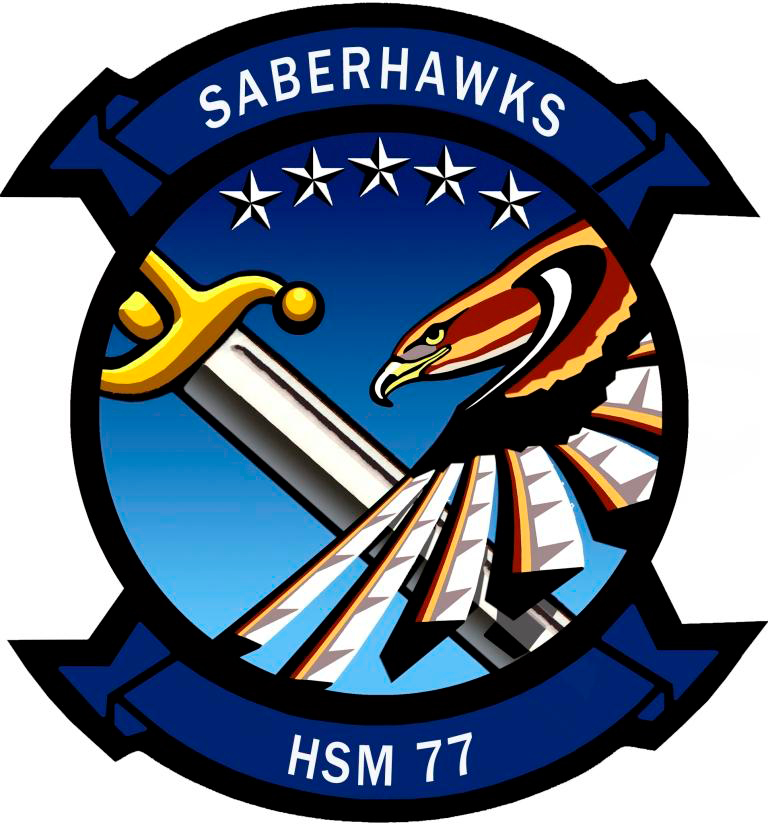
Naval Aviation Squadron Nicknames
HSM-77 Helicopter Maritime Strike (HSM) Squadron SEVEN SEVEN - nicknamed the “Saberhawks”
United States Navy - Marine Corps Commander, Helicopter Maritime Strike Wing Pacific - Naval Air Facility Atsugi, Japan. / HSL-47: September 25, 1987 - February 2009 / HSM-77: February 2009 - present

Where Did That Saying Come From?

“A golden key can open any door:”
Meaning: 'A golden key opens any door' is the opinion that sufficient money, or the promise of it, will allow the possessor of it to do anything they wish.
History: This notion must be as old as money itself. The first person who is known to have written it down is the English playwright John Lyly, in Euphues and his England, 1580:
“Who is so ignorant that knoweth not,
gold be a key for euery locke,
chieflye with his Ladye.”
Phrases.org.uk

Science & Technology

FEATURED: New insight into how the brain makes decisions in changing environments
• New possibilities for detecting Hawking radiation emitted by primordial black holese
One of the largest ever land mammals evolved into extinct dwarf elephant
• Molecule layer aids chemoselective hydrogenation on solid palladium catalysts
• Stronger together: How protein filaments interact
Ancient bones provide clues about Kangaroo Island's past and future
• New research into the spreading of infections reveals need for greater collaboration between biology and physics
• In the visual thalamus, neurons are in contact with both eyes but respond to only one
Best of Last Week: Trouble with Hubble, artificial photosynthesis, red meat's role in colorectal cancer
• Pathogenic bacteria rendered almost harmless
• Using satellite data to warn people about volcanic eruptions
Phys.org / MedicalXpress / TechXplore

FEATURED: Killer whales form killer friendships, new drone footage suggests
• Nutrition researchers urge update to lab animal diets
“It’s a tipping point:” Flood of COVID-19 vaccine donations buoys mood at World Health Organization (WHO)
• This ecologist thinks coastal wetlands can outrun rising seas - Not everyone’s convinced
This “living fossil” could reach 100 years old
• Newly detailed nerve links between brain and other organs shape thoughts, memories, and feelings
Ancient genomes offer rare glimpse of Neanderthal family groups
• NIH should boost rigor of animal studies with stronger statistics, pilot studies, experts say
Science AAAS

Bizarre News (we couldn’t make up stuff this good - real news story)
Humpback whale swallows lobster diver before spitting him out

The diver says he was in the whale's mouth for 30 seconds.
A humpback whale recently swallowed a Cape Cod lobster diver.
This is a highly unusual event, but one expert told Live Science that there are certain types of behaviors that could have led to the man being swallowed - such as diving too close to the whale's normal food.
Michael Packard was 45 feet (14 meters) deep in the coastal waters off Provincetown, Massachusetts when he was suddenly gulped inside the mouth of an enormous marine animal.
“All of a sudden, I felt this huge bump, and everything went dark”, he told WBZ-TV News.
At first he thought he had been attacked by a shark, as great whites frequent the area, but he soon realized he couldn't feel any teeth.
Then I realized, “Oh my God, I'm in a whale's mouth ... and he's trying to swallow me”, Packard told WBZ-TV News. “And I thought to myself ‘OK, this is it - I'm finally - I'm gonna die.’” Packard's thoughts turned to his wife and his two sons, ages 12 and 15.
He estimated that he remained trapped inside the mouth of the leviathan for 30 seconds, and he was still able to breathe through his scuba respirator. But then the whale, clearly keen to remove its unwelcome, and inedible, guest, surfaced, shook its head and spat him out.
“I just got thrown in the air and landed in the water”, he said. “I was free and I just floated there. I couldn't believe … I'm here to tell it.”
Packard was hauled back onto his fishing boat by his topside crew mate, who had been anxiously surveying the water's surface for signs of bubbles from Packard's oxygen respirator. Astonishingly, Packard survived the biblical encounter with no greater injury than a dislocated knee.
Getting swallowed by any marine creature is hardly going to make anyone's day, but Packard was somewhat fortunate that he was grabbed by a baleen whale. Despite being one of the largest whale species — growing up to 60 feet (18 m) long, and weighing an impressive 40 tons (36 metric tons) —the school bus-size giants predominantly dine on tiny sea creatures such as small fish, krill and plankton, meaning their throats are usually only 4 to 8 inches (10 to 20 centimeters) wide.
No one gobbled up by a humpback could end up in the beast's stomach, but the creature's 4 ton (3.8 metric tons) tongue could easily crush a person.

Rather than teeth, humpback whales have 270 to 400 nail-like strands called baleen plates. They hunt by opening their mouths to about 90 degrees before lunging at high speed with a swift swipe of their tails. This lunge generates drag that forces water, along with prey, into their mouths. After snapping their jaws shut, humpbacks expel water through their plates before swallowing the remaining prey.
And these whales can gulp a lot of water.
“The engulfment capacity of a humpback whale is upwards of 50,000 kilograms [110,230 pounds] of water (which is typically filled with prey like fish or krill)”, Jeremy Goldbogen, a biologist and co-director of the Hopkins Marine Station at Stanford University in California, told Live Science in an email. “So their expansive gulp could easily engulf a diver. I have never heard of this happening before with humans.”
Another whale expert told Live Science that Packard's encounter, while unusual, was an accident that could have been caused by him swimming too close to a “bait ball” - the swirling ball that sardines form when threatened on all sides by predators.
“Bait balls can form in open water as well as near the bottom. and whales start by feeding bottom-up in many areas. They may not see an object”, such as a diver, Hector Guzman, a marine biologist at Smithsonian Tropical Research Institute in Panama, told Live Science.
The only whale capable of eating an entire human is probably the sperm whale, the famed subject of Moby Dick known to swallow its prey - the 400-pound (180 kg) giant squid - whole. Once inside one of the sperm whale's four stomachs, a hapless human would likely asphyxiate on the gas before being pulped down by powerful muscles and dissolved by digestive acid.
There are, however, no reliable reports of any human having ever met such a grim fate, Live Science previously reported.
Related:Related: 8 Human-animal encounters that went horribly wrong
Live Science (06/15/2021) 


SONG FACTS

“Sympathy For The Devil”  - The Rolling Stones
- The Rolling Stones
Album: Beggars Banquet
Released 1968 
“Sympathy For The Devil”  perpetuated the image of the Stones as frightening bad boys, as opposed to the clean-cut Beatles. It was great marketing for the band, who got some press by implying an interest in the occult.
perpetuated the image of the Stones as frightening bad boys, as opposed to the clean-cut Beatles. It was great marketing for the band, who got some press by implying an interest in the occult.
The lyrics were inspired by The Master and Margarita, a book by Mikhail Bulgakov. British singer Marianne Faithfull was Mick Jagger's girlfriend at the time and she gave him the book. Faithfull came from an upper-class background and exposed Jagger to a lot of new ideas. In the book, the devil is a sophisticated socialite, a ‘man of wealth and taste”.
Jagger claims this is about the dark side of man, not a celebration of Satanism.
Said Mick Jagger:
The original title was “The Devil Is My Name... Songs can metamorphasize, and ‘Sympathy For The Devil’ is one of those songs that started off like one thing, I wrote it one way and then we started the change the rhythm. And then it became completely different. And then it got very exciting. It started off as a folk song and then became a samba. A good song can become anything. It's got lots of historical references and lots of poetry.”
Keith Richards (2002):
“‘Sympathy’ is quite an uplifting song. It's just a matter of looking the Devil in the face. He's there all the time. I've had very close contact with Lucifer - I've met him several times. Evil - people tend to bury it and hope it sorts itself out and doesn't rear its ugly head. ‘Sympathy For The Devil’ is just as appropriate now, with 9/11. There it is again, big time. When that song was written, it was a time of turmoil.
“It was the first sort of international chaos since World War II. And confusion is not the ally of peace and love. You want to think the world is perfect. Everybody gets sucked into that. And as America has found out to its dismay, you can't hide. You might as well accept the fact that evil is there and deal with it any way you can. Sympathy for the Devil is a song that says, Don't forget him. If you confront him, then he's out of a job.”
The Stones played this at the Altamont Speedway concert in 1969 before a fan was fatally stabbed. The crowd got more unruly as the song went on. The Stones were playing
“Under My Thumb”  when the stabbing occurred, but they did not perform
“Sympathy For The Devil”
when the stabbing occurred, but they did not perform
“Sympathy For The Devil”  ; for seven years after the incident due to the public outcry.
; for seven years after the incident due to the public outcry.
Some of the historical events mentioned in this song are the crucifixion of Christ, the Russian Revolution, World War II, and the Kennedy assassinations. Robert Kennedy was killed on June 5, 1968, after Mick Jagger started writing the song. His original lyric was “who killed Kennedy?” referring to the 1963 John F. Kennedy assassination, but he changed it to “who killed the Kennedys?”
Other historical events alluded to in the song include the Hundred Years' War (“fought for ten decades”) and the Nazi Blitzkrieg (“the blitzkrieg raged, and the bodies stank”).
The “whoo-whoo” backing vocals were added when Richard's girlfriend, Anita Pallenberg, did it during a take and the Stones liked how it sounded.
Pallenberg sang it on the record along with Keith Richards, Brian Jones, Bill Wyman, Marianne Faithfull and Jimmy Miller.
Stones producer Jimmy Miller:
“Anita (Pallenberg) was the epitome of what was happening at the time. She was very Chelsea. She'd arrive with the elite film crowd. During ‘Sympathy For The Devil’ when I started going whoo, whoo in the control room, so did they I had the engineer set up a mike so they could go out in the studio and whoo, whoo.”
The Stones performed this on Rock and Roll Circus, a British TV special The Stones taped in 1968 but never aired. It was released on video in 1995. During the performance, Jagger removes his shirt to reveal devil tattoos on his chest and arms.
The line, “And I laid traps for troubadours who get killed before they reach Bombay” possibly refers to the notorious Thuggee cult, who worshiped Kali, the Hindu goddess of death. They would waylay travelers on the roads of India, then kill the entire group in order to make off with their valuables. This seems to be the closest well known historical incident to fit the lyrics. Also, the Thuggee would have been well known in England, since the British Army put a stop to the cult during the colonial period.
Another interpretation is that the line refers to the hippies who traveled the “Hippie trail”, a passage through Turkey, Afghanistan, India and a few other countries that was popular in the counterculture community. Many of these travellers were killed and ripped off by drug peddlers in Afghanistan and Pakistan. Those shady deals could be the “traps”.
Fitting for a song about Satan, the song is heavy on the low end, with the bass, percussion and piano prominent throughout the track. The guitar doesn't come in until 2:50, when the solo comes in. It doesn't return until nearly two minutes later, when it returns for some licks. The Stones typically change the arrangement when they perform it live, bringing the guitar in for the first “pleased to meet you line”, sometimes punctuated with pyro or other visual elements.
Mick Jagger (1995):
“It has a very hypnotic groove, a samba, which has a tremendous hypnotic power, rather like good dance music. It doesn't speed up or down. It keeps this constant groove. Plus, the actual samba rhythm is a great one to sing on, but it's also got some other suggestions in it, an undercurrent of being primitive - because it is a primitive African, South American, Afro-whatever-you-call-that rhythm.
“So to white people, it has a very sinister thing about it. But forgetting the cultural colors, it is a very good vehicle for producing a powerful piece. It becomes less pretentious because it's a very unpretentious groove. If it had been done as a ballad, it wouldn't have been as good.”
“I knew it was a good song. You just have this feeling. It had its poetic beginning, and then it had historic references and then philosophical jottings and so on. It's all very well to write that in verse, but to make it into a pop song is something different. Especially in England - you're skewered on the altar of pop culture if you become pretentious.”
MORE SONGS

“Come On” (1963) 
“I Wanna Be Your Man” (1963) 
“Heart of Stone” (1964) 
“It's All Over Now” (1964) 
“Little Red Rooster (1964)” 
“Not Fade Away” (1964) 
“Tell Me” (1964); 
“Time Is on My Side” (1964) 
“You Better Move On” (1964) 
“What a Shame” (1964); 
“As Tears Go By” (1965) 
“Play with Fire” (1965) 
“(I Can't Get No) Satisfaction” (1965) 
“The Last Time” (1965) 
“Lady Jane” (1966) 
“Let's Spend the Night Together” (1967) 
“Under My Thumb” (1966) 
“Dandelion” (1967) 
“Honky Tonk Women” (1969) 
“Sympathy for the Devil” (1969) 
“Brown Sugar” (1971) 
“Wild Horses” (1971) 
“Angie” (1973) 
“You Can't Always Get What You Want” (1973) 
“It's Only Rock 'n Roll” (But I Like It) (1974) 
“Beast of Burden” (1978) 
The Rolling Stones official site (The Rolling Stones Discography) / Rock & Roll Hall of Fame / Billboard / All Music / Song Facts / Ultimate Classic Rock / The Rolling Stones
Image: “Beggars Banquet (album)” by The Rolling Stones

Halloween Holiday Trivia
● Orange and black are Halloween colors because orange is associated with the Fall harvest and black is associated with darkness and death.
● Jack o’ Lanterns originated in Ireland where people placed candles in hollowed-out turnips to keep away spirits and ghosts on the Samhain holiday.
● The ancient Celts thought that spirits and ghosts roamed the countryside on Halloween night. They began wearing masks and costumes to avoid being recognized as human.
● Pumpkins also come in white, blue and green. Great for unique monster carvings!
● Halloween was brought to North America by immigrants from Europe who would celebrate the harvest around a bonfire, share ghost stories, sing, dance and tell fortunes.
● Tootsie Rolls were the first wrapped penny candy in America.
● Chocolate candy bars top the list as the most popular candy for trick-or-treaters with Snickers #1.
● Bobbing for apples is thought to have originated from the roman harvest festival that honors Pamona, the goddess of fruit trees.
● There really are so-called vampire bats, but they're not from Transylvania. They live in Central and South America and feed on the blood of cattle, horses and birds.
● Signs of a werewolf are a unibrow, hair palms, tattoos, and a long middle finger.
● Black cats were once believed to be witch's familiars who protected their powers.
● Many people still believe that gargoyles were created by medieval architects and stone carvers to ward off evil spirits.
● The fear of Halloween is known as Samhainopobia.
● The first Jack-o-Lanterns were made out of what?
The first Jack-o-Lanterns were made in Ireland out of hollowed-out turnips. A piece of coal was inserted into the hollow and the “lantern” was meant to guide the way of poor old Jack who wasn't welcome in Heaven but was also barred from entering Hell for tricking the devil. According to legend, the devil gave this crude lamp to Jack so that he could walk the earth forever in limbo. When the Irish brought this tradition to America, they apparently decided that pumpkins were easier to carve than turnips, and the modern-day Jack-o-Lantern was born!
● Halloween is generally considered to have evolved from what ancient festival?
Although there are many theories on the origin and history of Halloween, it is generally accepted that Halloween dates back to an ancient Celtic festival known as Samhain, or the Celtic New Year. It was believed that the spirits of everyone who had died during the year would return on the eve of Samhain to seek living bodies to possess for the following year. The Celts would dress in ghoulish costumes and hold noisy revels in an attempt to frighten away these spirits. Food and drink was also offered to pacify the dead. There are many tales of unfortunate souls being burned at the stake because they were perceived to have been possessed by one of the returning spirits. Around the turn of the first century AD, Romans abandoned this custom of human sacrifice in favor of the burning of effigies.
● According to legend, a unibrow, tattoos, and a long middle finger are all signs of what Halloween creature?
According to legend, a unibrow, tattoos, hairy palms, and a long middle finger are all signs of a werewolf. Other common traits include unusual strength, an irrational fear of water, and glow-in-the-dark red eyes.
● If you want to keep spirits out of your home on Halloween, what should you sprinkle on your doorstep?
According to tradition, salt can be laid around the boundaries of a room to prevent spirits and demons from entering.
● In what century did the practice of trick-or-treating begin?
In North America, trick-or-treating began to develop as a Halloween tradition during the 1920s, but the European tradition of going house-to-house collecting food at Halloween goes back at least as far as the 16th century. In Britain and Ireland, there are many accounts of people going house-to-house in costume at Halloween, reciting verses in exchange for food, and sometimes warning of misfortune if they were not welcomed.

A Test for People Who Know Everything
From the Jeopardy Archives Category - “A STAR-SPANGLED BANNER LYRICAL QUIZ” ($200)
“They provide a ‘red glare’ to the battle scene.”
Answer to Jeopardy READ MORE: National Museum of American History
From the Jeopardy Archives Category - “A STAR-SPANGLED BANNER LYRICAL QUIZ” ($400)
“Verse 4 says, ‘Then conquer we must, when our cause it is just, And this be our motto - ‘In God is our’ ’.”
Answer to Jeopardy READ MORE: National Museum of American History
From the Jeopardy Archives Category - “A STAR-SPANGLED BANNER LYRICAL QUIZ” ($600)
“The ‘towering steep’ in verse 2 is this edifice that was under attack by the British.”
Answer to Jeopardy READ MORE: National Museum of American History
From the Jeopardy Archives Category - “A STAR-SPANGLED BANNER LYRICAL QUIZ” ($800)
“In a kids' book this phrase leads Ramona Quimby to think a lamp is called a dawnzer.”
Answer to Jeopardy READ MORE: Idaho Statesman
From the Jeopardy Archives Category - “A STAR-SPANGLED BANNER LYRICAL QUIZ” ($1,000)
“This phrase about liberty in all 4 verses provides the title of a song by The Killers where it has a more ironic meaning.”
Answer to Jeopardy READ MORE: YouTube
Joke of the Day

“First Date”
To Meet The Parents
A girl asks her boyfriend to come over Friday night and have dinner with her parents.
Since this is such a big event, the girl announces to her boyfriend that after dinner, she would like to go out and make love for the first time.
Well, the boy is ecstatic, but he has never had sex before, so he takes a trip to the pharmacist to get some condoms.
The pharmacist helps the boy for about an hour.
He tells the boy everything there is to know about condoms and sex.
At the register, the pharmacist asks the boy how many condoms he'd like to buy, a 3-pack, 10-pack, or family pack.
The boy insists on the family pack because he thinks he will be rather busy, it being his first time and all.
That night, the boy shows up at the girl's parents house and meets his girlfriend at the door. “Oh, I'm so excited for you to meet my parents, come on in!”
The boy goes inside and is taken to the dinner table where the girl's parents are seated.
The boy quickly offers to say grace and bows his head.
A minute passes, and the boy is still deep in prayer, with his head down.
10 minutes pass, and still no movement from the boy.
Finally, after 20 minutes with his head down, the girlfriend leans over and whispers to the boyfriend, “I had no idea you were this religious.”
The boy turns, and whispers back, “I had no idea your father was a pharmacist.”


































